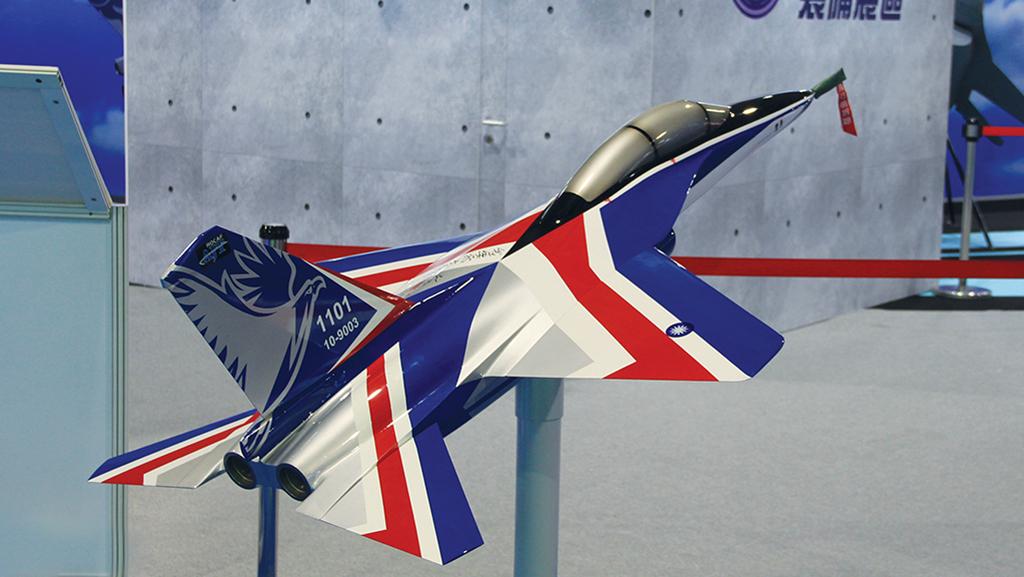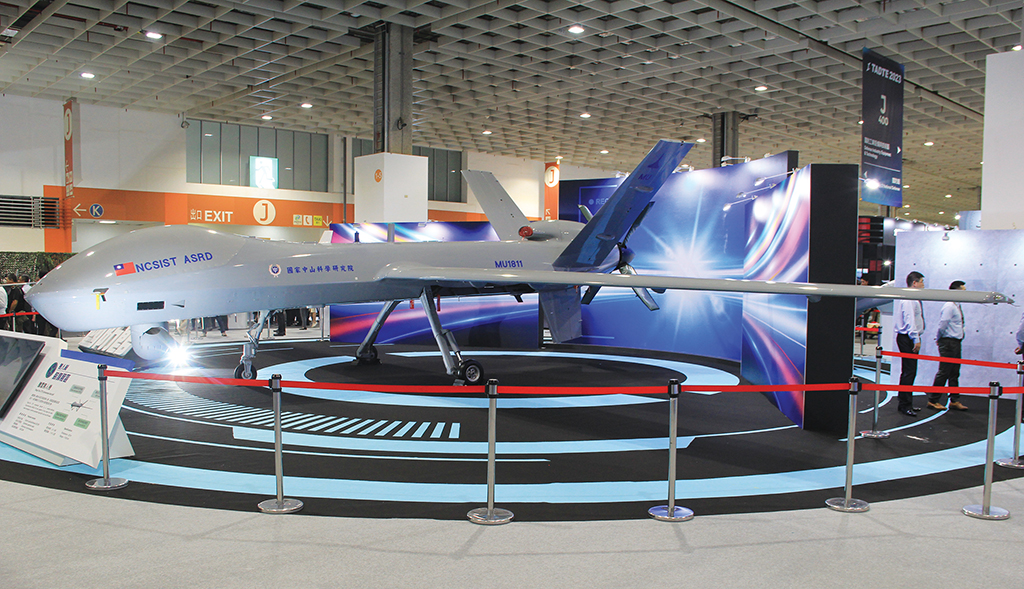Fate Of Taiwan’s Next Military Aircraft Project Still Undecided

The last of 66 T-5 Brave Eagle advanced jet trainers will be delivered to the Taiwanese Air Force in 2026.
Ma Wan-june picked an auspicious time to be president of Taiwan’s largest aerospace company. As Taiwan’s annual defense spending has soared by two-thirds in five years, sales for Aerospace Industrial Development Corp. are on track this year to break a record set in 2022. The privately owned company, founded in 1969, has been playing a greater role as a parts supplier in the global aviation supply chain, and this year it reached full-rate production of an indigenously designed advanced jet trainer.
But the company’s future as a designer and manufacturer of military aircraft is not settled. Aerospace Industrial Development Corp. (AIDC), also known as Hanxiang in Taiwan, is scheduled to deliver all 66 T-5 Brave Eagle jet trainers to the Taiwanese Air Force in 2026. AIDC hopes for a follow-on contract from the air force to design and build a new basic trainer in the near term and perhaps a next-generation fighter in the long term. The final decisions on those proposals, however, belong to the government during a presidential election cycle.
- Basic trainer is next in line for AIDC
- Next-generation fighter and engine projects await go-ahead
“I’ve tried to organize the industries in Taiwan to do this mission, but the [decision] is coming from the [government],” Ma said in an exclusive interview with Aviation Week on Sept. 14. “So I have to wait for the decision of the air force.”
Waiting for a government decision has paid off in the past for AIDC. In the 1970s, Taiwan wanted to buy American or French fighters to replace Lockheed F-104s, but none were forthcoming. In response, the government tasked the then-state-owned AIDC in the early 1980s to develop the Indigenous Defense Fighter (IDF), which the company delivered in 1992 as the Honeywell/AIDC F125-powered F-CK-1 Ching-Kuo. In the interim, the international backlash to the Tiananmen Square massacre in 1989 loosened export restrictions, allowing the F-CK-1 to be fielded alongside imported Lockheed Martin F-16A/Bs and Mirage 2000-5s during the 1990s.
A decade ago, the Taiwanese Air Force started searching for a replacement for the AIDC AT-3s and Northrop F-5s serving as jet trainers. Initially, the government wanted to import an aircraft, and AIDC signed a memorandum of understanding in 2014 with Alenia Aermacchi, now a part of Leonardo, to assemble M-346 trainers in Taiwan.
But Tsai Ing-wen, who was elected Taiwan’s president in 2016 as leader of the Democratic Progressive Party, changed that plan. As the cornerstone of a new policy supporting domestic aircraft manufacturing, AIDC launched the Brave Eagle program in 2017 to develop the T-5 trainer as a derivative of the F-CK-1. First flight of the T-5 followed three years later, and low-rate production began in 2021.
Now the time has come for the air force’s next modernization program. A fleet of Beechcraft T-34C basic trainers delivered to Taiwan in the mid-1980s are nearing the 40-year service mark and need to be replaced.
Taiwan has released a plan to spend NT$224 billion ($7 billion) over the 2024-28 period on defense acquisitions, but so far a research and development program for AIDC to develop a basic trainer is not included. Moreover, a basic trainer project went unmentioned in the 2023 National Defense Report published by the government on Sept. 12.
Local news reports say AIDC’s proposal is still being discussed within the government, but so is a plan to lease basic trainers from another country. AIDC is on track to approach or exceed $1 billion in annual revenue for the first time this year, but Ma has ruled out a self-funded effort to develop a basic trainer.
“AIDC is a very big company in Taiwan, but around the world, we are a small one,” Ma said. “The [aircraft business] model in Taiwan is that the government will issue the budget for design and development to industry, and they will design, develop and test [the aircraft] after that. I think this is a good model because we are a small industry.”
If the government budget is approved, AIDC views the basic trainer project as a critical step toward greater self-sufficiency for Taiwan’s defense industry.
Although AIDC has produced trainers and the F-CK-1 fighter, the company’s supply chain heavily relies on foreign companies. Taiwanese companies contributed about 48% of the F-CK-1 in the 1990s and account for about 55% of the T-5 trainer today. That dependence creates political risks for a government that is officially recognized as an independent state by only 14 countries.
“Sometimes we cannot get help from the international supply chain, so we have to do many things by ourselves,” Ma said.
As a relatively small producer, AIDC is also forced to manage supply chain disruptions around the world to meet delivery targets.
“I have to keep flying around the world to gather my parts,” Ma said. “In my mind, for the next-generation military aircraft after the Brave Eagle, we should raise the [percentage of] self-manufactured and self-designed parts. For the next one—the basic trainer—[we should] move up to 70%, I think, from 55%.”
Taiwan’s aerospace industry has also been preparing for a more ambitious project. The Advanced Defense Fighter (ADF) program is classified, but several official statements over the years have confirmed that low-level development activity has been underway for nearly a decade, although no decision has been made to proceed with full-scale development and production.
The need for a new indigenous fighter program is under debate. In a year or two, Taiwan will start receiving the first of 66 F-16V Block 70/72 fighters, augmenting an aging force of upgraded F-16 Block 20s, Mirage 2000-5s and F-CK-1s. The country is also adjusting its national security posture by investing in asymmetric capabilities, such as uncrewed air vehicles, cruise missiles and one-way attack munitions.

But Taiwan’s defense industry believes there is a pattern to unlocking U.S. defense exports. Notwithstanding the backlash to the Tiananmen Square massacre, the U.S. and France approved exports of F-16 and Mirage fighters only after the F-CK-1 prototype flew. Similarly, the sale of General Atomics Aeronautical Systems MQ-9Bs to Taiwan occurred only after the domestic industry produced the Teng Yun II, a medium-altitude, long-endurance aircraft in the same class. Likewise, the successful introduction of a future ADF prototype might spur Washington to approve exports of a more advanced fighter than the F-16 to Taiwan.
Multiple Taiwanese newspapers have reported on Ma’s comments about the ADF program. In an interview in June with Liberty Times, Ma said the basic configuration of the aircraft design was finished “a long time ago.” In his interview with Aviation Week, Ma said he has spoken only generally about future military aircraft, not specifically the ADF. Even so, Ma said Taiwan’s aerospace industry is ready to start developing an advanced fighter.
“We can design a whole aircraft, and we can construct a supply chain for this aircraft,” Ma said. “So this valuable capability [allows us] to design any kind of aircraft, including the next-generation fighter.”
The ADF program also created an opportunity to develop Taiwan’s aircraft propulsion industry. AIDC partnered with Honeywell to produce the F125 for the twin-engine F-CK-1 fighter, but the U.S. manufacturer contributed the design and the hot section. Nearly a decade ago, Taiwan launched the secretive Vega Project to develop the capability to design and build a complete fighter engine with about 16,000 lb. of thrust, or roughly twice the power of a single F125.
Taiwan has released few details about Vega, but an official provided a rare update. In an address to the Foreign and National Defense Committee of the Legislative Yuan on May 25, Zhang Zhongcheng, president of the National Chung-Shan Institute of Science and Technology, said a $310 million phase for basic research and development on the Vega Project will be complete by 2024. No decision has been made on funding a follow-on effort for full-scale development and testing.
Ma, a Tawainese aerospace industry veteran, said the government, not industry, must make the decision to invest in a new fighter engine. Taiwan also has the option simply to acquire a U.S.- or European-made engine for the ADF, if the project advances. Ma, however, hopes that Taiwan will be capable of producing powerful military aircraft engines in the future.
“I think the really important thing we should do is let us design the engines,” Ma said. “I wish Taiwan can go in that direction.”

